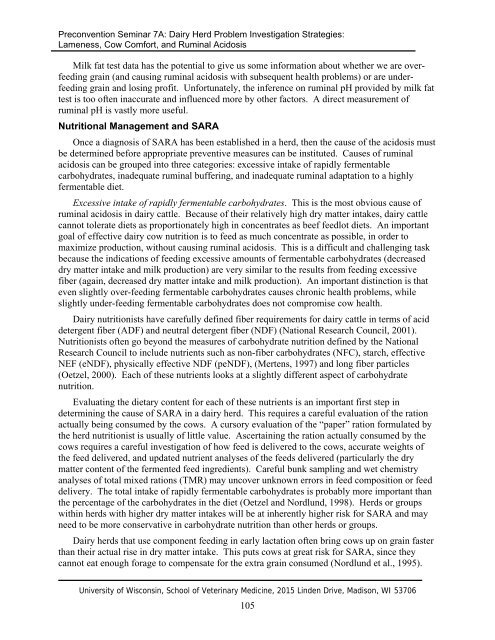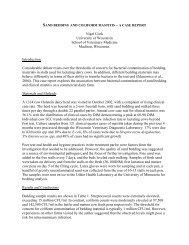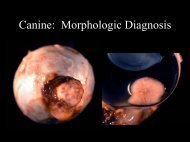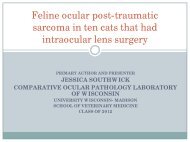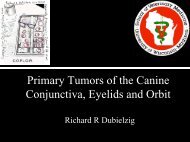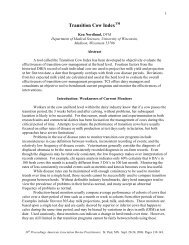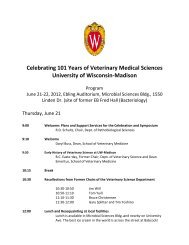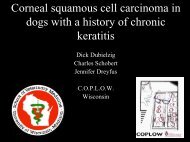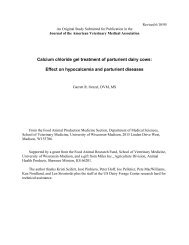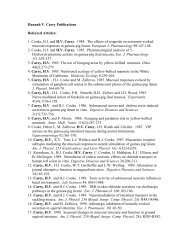Subacute Ruminal Acidosis in Dairy Herds - University of Wisconsin ...
Subacute Ruminal Acidosis in Dairy Herds - University of Wisconsin ...
Subacute Ruminal Acidosis in Dairy Herds - University of Wisconsin ...
You also want an ePaper? Increase the reach of your titles
YUMPU automatically turns print PDFs into web optimized ePapers that Google loves.
Preconvention Sem<strong>in</strong>ar 7A: <strong>Dairy</strong> Herd Problem Investigation Strategies:Lameness, Cow Comfort, and <strong>Rum<strong>in</strong>al</strong> <strong>Acidosis</strong>Milk fat test data has the potential to give us some <strong>in</strong>formation about whether we are overfeed<strong>in</strong>ggra<strong>in</strong> (and caus<strong>in</strong>g rum<strong>in</strong>al acidosis with subsequent health problems) or are underfeed<strong>in</strong>ggra<strong>in</strong> and los<strong>in</strong>g pr<strong>of</strong>it. Unfortunately, the <strong>in</strong>ference on rum<strong>in</strong>al pH provided by milk fattest is too <strong>of</strong>ten <strong>in</strong>accurate and <strong>in</strong>fluenced more by other factors. A direct measurement <strong>of</strong>rum<strong>in</strong>al pH is vastly more useful.Nutritional Management and SARAOnce a diagnosis <strong>of</strong> SARA has been established <strong>in</strong> a herd, then the cause <strong>of</strong> the acidosis mustbe determ<strong>in</strong>ed before appropriate preventive measures can be <strong>in</strong>stituted. Causes <strong>of</strong> rum<strong>in</strong>alacidosis can be grouped <strong>in</strong>to three categories: excessive <strong>in</strong>take <strong>of</strong> rapidly fermentablecarbohydrates, <strong>in</strong>adequate rum<strong>in</strong>al buffer<strong>in</strong>g, and <strong>in</strong>adequate rum<strong>in</strong>al adaptation to a highlyfermentable diet.Excessive <strong>in</strong>take <strong>of</strong> rapidly fermentable carbohydrates. This is the most obvious cause <strong>of</strong>rum<strong>in</strong>al acidosis <strong>in</strong> dairy cattle. Because <strong>of</strong> their relatively high dry matter <strong>in</strong>takes, dairy cattlecannot tolerate diets as proportionately high <strong>in</strong> concentrates as beef feedlot diets. An importantgoal <strong>of</strong> effective dairy cow nutrition is to feed as much concentrate as possible, <strong>in</strong> order tomaximize production, without caus<strong>in</strong>g rum<strong>in</strong>al acidosis. This is a difficult and challeng<strong>in</strong>g taskbecause the <strong>in</strong>dications <strong>of</strong> feed<strong>in</strong>g excessive amounts <strong>of</strong> fermentable carbohydrates (decreaseddry matter <strong>in</strong>take and milk production) are very similar to the results from feed<strong>in</strong>g excessivefiber (aga<strong>in</strong>, decreased dry matter <strong>in</strong>take and milk production). An important dist<strong>in</strong>ction is thateven slightly over-feed<strong>in</strong>g fermentable carbohydrates causes chronic health problems, whileslightly under-feed<strong>in</strong>g fermentable carbohydrates does not compromise cow health.<strong>Dairy</strong> nutritionists have carefully def<strong>in</strong>ed fiber requirements for dairy cattle <strong>in</strong> terms <strong>of</strong> aciddetergent fiber (ADF) and neutral detergent fiber (NDF) (National Research Council, 2001).Nutritionists <strong>of</strong>ten go beyond the measures <strong>of</strong> carbohydrate nutrition def<strong>in</strong>ed by the NationalResearch Council to <strong>in</strong>clude nutrients such as non-fiber carbohydrates (NFC), starch, effectiveNEF (eNDF), physically effective NDF (peNDF), (Mertens, 1997) and long fiber particles(Oetzel, 2000). Each <strong>of</strong> these nutrients looks at a slightly different aspect <strong>of</strong> carbohydratenutrition.Evaluat<strong>in</strong>g the dietary content for each <strong>of</strong> these nutrients is an important first step <strong>in</strong>determ<strong>in</strong><strong>in</strong>g the cause <strong>of</strong> SARA <strong>in</strong> a dairy herd. This requires a careful evaluation <strong>of</strong> the rationactually be<strong>in</strong>g consumed by the cows. A cursory evaluation <strong>of</strong> the “paper” ration formulated bythe herd nutritionist is usually <strong>of</strong> little value. Ascerta<strong>in</strong><strong>in</strong>g the ration actually consumed by thecows requires a careful <strong>in</strong>vestigation <strong>of</strong> how feed is delivered to the cows, accurate weights <strong>of</strong>the feed delivered, and updated nutrient analyses <strong>of</strong> the feeds delivered (particularly the drymatter content <strong>of</strong> the fermented feed <strong>in</strong>gredients). Careful bunk sampl<strong>in</strong>g and wet chemistryanalyses <strong>of</strong> total mixed rations (TMR) may uncover unknown errors <strong>in</strong> feed composition or feeddelivery. The total <strong>in</strong>take <strong>of</strong> rapidly fermentable carbohydrates is probably more important thanthe percentage <strong>of</strong> the carbohydrates <strong>in</strong> the diet (Oetzel and Nordlund, 1998). <strong>Herds</strong> or groupswith<strong>in</strong> herds with higher dry matter <strong>in</strong>takes will be at <strong>in</strong>herently higher risk for SARA and mayneed to be more conservative <strong>in</strong> carbohydrate nutrition than other herds or groups.<strong>Dairy</strong> herds that use component feed<strong>in</strong>g <strong>in</strong> early lactation <strong>of</strong>ten br<strong>in</strong>g cows up on gra<strong>in</strong> fasterthan their actual rise <strong>in</strong> dry matter <strong>in</strong>take. This puts cows at great risk for SARA, s<strong>in</strong>ce theycannot eat enough forage to compensate for the extra gra<strong>in</strong> consumed (Nordlund et al., 1995).<strong>University</strong> <strong>of</strong> Wiscons<strong>in</strong>, School <strong>of</strong> Veter<strong>in</strong>ary Medic<strong>in</strong>e, 2015 L<strong>in</strong>den Drive, Madison, WI 53706105


